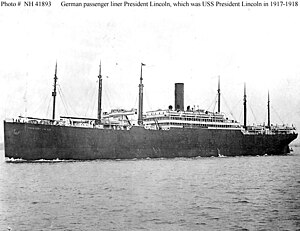
| |
| History | |
|---|---|
| Name | President Lincoln |
| Namesake | Abraham Lincoln |
| Builder | Harland and Wolff |
| Yard number | 353 |
| Launched | 8 October 1903 |
| Completed | 14 May 1907 |
| Acquired | Confiscated, 1917 |
| Commissioned | 25 July 1917 |
| Fate | Sunk 31 May 1918 |
| General characteristics | |
| Type | Troop transport |
| Tonnage | 18,084 GRT |
| Displacement | 32,500 long tons (33,000 t) |
| Length | 619 ft (189 m) |
| Beam | 68 ft 2 in (20.78 m) |
| Draft | 34 ft (10 m) |
| Propulsion | Steam engine(s) |
| Speed | 14.5 kn (26.9 km/h; 16.7 mph) |
| Complement | 430 officers and enlisted |
| Armament | 4 × 6 in (150 mm) guns |
USS President Lincoln was a troop transport in the United States Navy during World War I.
Formerly the German steamer President Lincoln of the Hamburg-American Line, it was built by Harland and Wolff in Belfast, being completed in 1907. Seized in New York harbor in 1917, it was turned over to the Shipping Board and transferred to the Navy for operation as a troop transport.
Having been damaged severely by her German crew, the President Lincoln underwent extensive repairs and conversion at Robin's Dry Dock and Repair Company in Brooklyn, New York before being re-commissioned as a Navy troop transport at Brooklyn on 25 July 1917. Commander Yates Stirling Jr. was then placed in command.
